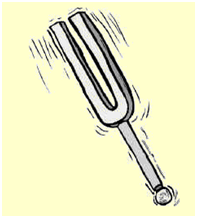We know that sound is the form of energy. We hear different types of sounds around us. Sounds include the chirping of birds, musical instruments, vehicle horns, sound from sound systems and vessels. Have you ever thought, where the sound is produced? What type of sound is produced by the vibration of objects. In this article, let us know in detail about sound production and the sound produced by the vibration of objects.
| Table of Contents: |
Sound Production
Where words cannot be heard, music speaks. Music and sound are part of our everyday life. A sound is a form of energy that gives us hearing experience. We see objects around us with the help of eyes by detecting light from objects. In the same way, ears are used to detect sound. The sound is produced by the vibration of objects and is propagated through a medium from one location to another. The to and fro or back and forth motion of an object is termed as vibration. The motion of objects causes vibrations. In many cases, we can see the vibrations with our naked eyes. While in some cases their amplitude is so small that we cannot see them but can experience them. The loudness of sound depends on its amplitude.
Examples of Sound Produced by Vibration of Objects
Let us understand the concept of sound produced by the vibration of an object with an example. We might have seen people playing the guitar. In guitar when they pluck the strings of a guitar, it vibrates and produces sound. The sound produced by it travels through the air which acts as the medium.

Another example to explain Sound Production by vibrating objects in a tuning fork. A fork consists of two tines and a handle. When it is hit with a rubber hammer, the two tines start vibrating. The back and forth motion of tines produce disturbances in the surrounding air molecules. As the tines extend outward from their original position, they compress surrounding air molecules which result in the creation of a high-pressure region close to the tine. When the tine moves inwards, it produces a low-pressure region near the tine. With more vibrations of tine, an alternating pattern of high and low-pressure regions is created. These pressure difference regions help in the propagation of sound waves from one location to another.
The sound produced is transmitted through pressure waves within the object. An object vibrating back and forth rapidly pushes air forward to make way for itself. When a force is applied on an atom, it moves from its original position and exerts a force on the adjacent atom. This motion from one particle to another continues throughout the medium. In this manner, the sound is transmitted through a medium.

Did You Know?
1. The voice box or the larynx is the source of sound production in human beings.
2. When a tightly stretched band is plucked, it vibrates and produces sound. It is not produced when the band stops vibrating.
3. Number of oscillations per second is known as the frequency of oscillation, and the frequency is expressed in hertz.
4. The frequency determines the shrillness or pitch of a sound.
See the video below for the visualization of the sound.

Frequently Asked Questions – FAQs
What is sound?
Sound is a form of energy that propagates as an acoustic wave. It is produced by the vibration of the objects.
Can sound travel through solid and liquid mediums?
Yes, sound can travel through solid and liquid mediums.
Which is the medium through which the sound cannot travel?
Sound cannot travel through vacuum.
State true or false: Sound is produced by vibrating objects.
What is noise?
Noise is defined as the excessive unwanted or unpleasant sounds.




Comments